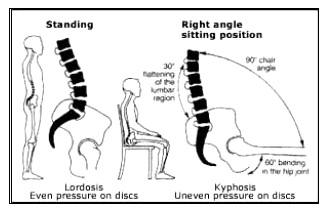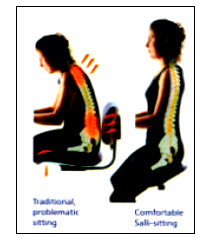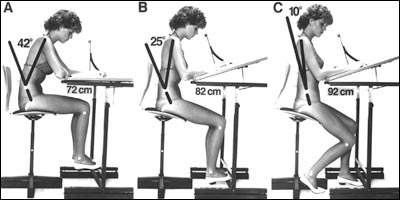|
Is
chronic back pain caused by the manner in which we sit? For many people,
this could be the case, according to a growing number of experts in the
field of ergonomics. Add to this the fact that we are fast becoming an
information processing society, in which increasing numbers of workers
transact business while sitting for long periods of time, and we begin to
see the crucial role that sitting may play. For modern researchers, many of
the ideas proposed two decades ago by Danish surgeon, A.C. Mandal, M.D.,
regarding the spine began a major paradigm shift in the way we evaluate the
seated worker. Many of these ideas have been validated in more recent
studies. Simply put, Mandal believed that the century-old concept of
proper sitting - upright with a hip angle of 90° - was all wrong. This type
of traditional sitting, still practiced today and considered by many to be
the one proper way of sitting, is now known to decrease lordosis (the
natural or inward curvature) of the lumbar region of the spine, and increase
kyphosis (or an outward rounding of this region of the spine). This
is exactly the opposite of what we need, in terms of posturally healthy
sitting - we should avoid kyphosis in the low back and maintain a
moderate level of lordosis. For us, this would mean incorporating the
natural curves of the spine into our seated posture,
neither flattening nor exaggerating these curves.
When
standing erect, the spine assumes a posture
of natural lordosis, while kyphosis is difficult to avoid in
traditional seated postures. Virtually all experts now consider a proper
degree of lordosis in both sitting and standing postures to be
critical in maintaining a healthy spine.

Some
of the known negative effects of traditional, 90° sitting include:
-
The erect spinal posture tends to
collapse as the upper back bulges out, leading to a
posture that may encompass shoulder, neck, and back
muscle tension, misaligned vertebrae, and a rounding of the low back (kyphosis).
-
The circulation in the lower extremities weakens, possibly leading to
varicose veins, cellulite, bloated feet, fatigue, and a risk of blood
clotting in the legs.
-
When we sit for long periods, we also expose much of our body to the
effects of static loading, which can result in fluid loss to the spinal
discs, and can quickly fatigue muscles. Try sitting all day at a seminar
on one of those easy to stack chairs that hotels always seem to provide
at such events, and see if you don’t feel seriously fatigued by the end
of the day.
-
In children, due to an increase in computer use in the classroom, there
is now a strong link between traditional 90° seated
posture and the development of scoliosis - an
abnormal curvature of the spine laterally during periods of adolescent
growth. (Koskelo et al, 2001)
Mandal
emphasized a way of sitting where posture
approached the spine’s natural resting position. He called this
balanced sitting. A hip angle of 135°, or a forward seat pan tilt of
45°-55° from the horizontal creates the optimum balanced
posture for the low back, to the point
that a backrest is no longer necessary. Research
shows that in this half standing posture,
spinal disc pressure is at its lowest.
This
seemingly radical concept is not new, however. Going back to as early as
3100 BC, for example, there is evidence that forward tilt (of the seat pan)
and, later, reclined forms of seating, were used by both nobility and
craftsmen. The purpose appears to have been both for comfort and to enable
them to get closer to their work.
Basic
options to sitting in this balanced posture
might include using:
The Standard Office Chair, with a forward seat pan tilt adjustment feature.
Kneeling Chairs,
a Norwegian design from the early 1980’s, where the weight of your body is
supported by knee rests. The knock on these is that many people end up with
knee problems after extended use.
Sit/Stand Stool
these allow a near-standing posture,
but are generally only used to provide some support to workers who must
stand when performing their jobs - like cashiers, for example.
Saddle
Chairs, where you sit equestrian-style with no back support.
Of
these, probably the easiest to adapt to your workplace is the standard chair
with the forward seat pan tilt. Unfortunately, only a small percentage of
chairs offer this adjustment, and those that do generally don’t tilt far
enough to achieve the desired effect. Also, users who do try this technique
generally complain that they feel like they are sliding out of their chairs.
The
most promising of these options may actually be the
saddle chair.
Mandal noted that equestrian riders were able to maintain an ideal
spinal posture, enhanced by the fact that
the saddle required a wide leg stance.
There are several types of saddle chairs
available. These backless adjustable chairs offer the recommended forward
tilt, the wide equestrian stance, and excellent mobility for the user. The
saddle chair appears equally suitable for
office/computer-related tasks, light assembly work, the medical field, and
customer service jobs. Saddle Stools manufacturer’s warn, however,
that there are some pre-conditions to its successful usage:
-
The desk or work surface height usually needs to be raised to put the
user into an optimal position, and to avoid introducing a new ergonomic
problem into the mix.
-
Tight skirts are not possible, due to the wide stance required, and
loose clothing is recommended.
- A
short break-in period is required, which may include some sore muscles
for a few days.
-
There is a psychological transition as well. The user must be willing to
try the equestrian posture. The
manufacturer states that most users are fully adapted to the Saddle
within two weeks
The benefits to this type
of chair may include:
 |
-
Apparent ease
at maintaining the hollow of the low back in a balanced
posture (lumbar lordosis).
-
Improved
circulation to the lower extremities, resulting in, among other
things, less fatigue.
-
As the upper
body stays more relaxed, muscle tension is minimized.
-
Excellent
mobility - it is easy to move around on the chair, reach for
items, and getting on and off the chair is effortless.
-
Fairly
adaptable for standing-height work as well.
|
Only
time - and future research - will tell
if some of these new concepts in seating hold true. But finding a posturally
healthy, balanced way of sitting seems to make a lot of sense. The ancient
Egyptians learned this, but apparently history forgot. For the sake of our
backs, let’s hope that we don’t.
References
Mandal, A.C.
“Balanced Sitting
Posture on Forward Sloping Seat” ,
http://www.acmandal.com/ ,2003
Mandal, A.C. “The
Seated Man”, (homo sedens). Dafnia Publications, Klampenborg, Denmark.
1985.
Pynt, J., et al.
“Milestones in the Evolution of lumbar Spinal Postural Health in Seating”,
Spine, Volume 27, Number 19 (2002):2180-2189.
Vollowitz, E.
“Furniture prescription for the conservative management of low-back pain”,
Topics in Acute Care and Trauma Rehabilitation 1988:2(4):18-37
Peters, H.
“Report by the German TUV”,
http://www.mindcom.fi/easydoing/english/default.htm, 2002.
Saukonpaa, H.
“Extracts from the thesis of physiotherapist, Helena Saukonpaa”.
http://www.mindcom.fi/easydoing/english/default.htm,
1994.
Koskelo, R., et al.
“University of Kuopio study for high school students”,
http://www.mindcom.fi/easydoing/english/default.htm,
2001.
Extracted
from an article by
Jeff Tiedeman,
an Ergonomics Consultant with State Fund, is a Certified Safety Professional
(CSP), a Board-Certified Industrial Ergonomist (CIE) and is certified as an
Associate in Risk Management (ARM). He has done extensive
research on specialized topics related to ergonomics,
including illumination in the workplace, and has written articles and taught
classes on these subjects.
For full article go to
http://www.scif.com/pdf/sftySeatingConcepts.pdf
Information or
recommendations contained in this article were obtained from sources
believed to be reliable at the date of publication. This information is only
advisory and does not presume to be exhaustive or inclusive of all workplace
hazards or situations.
|
Balanced sitting posture on forward
sloping seat
by A.C.Mandal.MD.
Copenhagen |
Our industrialized society is transforming into
an information processing society in which more employees are transacting
business while sitting for long periods of time.
With the advent of the information processing age, it is becoming
increasingly clear that there is a significant mismatch between people and
the furniture in their working environments, as is evident from the
increasing numbers of employees suffering from chronic backpain.
The most likely explanation is that we are sitting in the wrong way, thereby
abusing our backs, necks and arms.
Experts from all over the world have
formerly been of the opinion that the proper sitting position is the right
angle or erect position, illustrated by this selection of drawings that form
the basis for international standardization, anthropometrics and the
training of furniture designers. (fig.1)

Fig. 1
For the last century, work chairs in
schools, factories and offices have been designed for sitting upright, with
the hip, knees and ankles all at right angles. Untill recently, it was
widely believed that people sat with a 90-degree bending of the hip joint
while preserving lordosis (concavity) of the back.
Fig. 2
The erect posture looks very nice, but it is
impossible to sit this way for long and there is no scientific basis for it.
It is entirely based on wishful thinking, morals and discipline from the
days of Queen Victoria. This erect sitting posture cannot be maintained for
more than one or two minutes, and usually results in fatigue, discomfort and
poor posture.
In 1962, the German orthopedic surgeon, Hanns Schoberth, demonstrated by
x-ray photos that in a seated work position, you can only bend about 60
degrees in the hip-joints, not 90 degrees as shown in the drawings in fig.1.
This means that when moving from a standing (lordosis) to an upright sitting
position, you bend the hip-joints about 60 degrees and rotate the pelvis
axis backwards, flattening the lumbar-curve (kyphosis) of the back 30
degrees and straining the muscles of the back. (fig.2) When leaning forward
over the desk, you have to bend another 40-50 degrees, and this bending
mainly takes place in the 4th and 5th lumbar discs. Even the best lumbar
support will hardly have any influence on the posture when leaning over the
desk.
 J.J.Keegan,
an American Orthopedic surgeon, made in 1953 a series of x-rays of people
lying on their sides which documented the large movements that took place in
the lumbar section of the spinal column as the position changed from
standing (a) to right angle sitting
(c) and bent-over positions (d).(b)
is the natural resting position, as when you lie on your side while
sleeping. The lumbar curve is retained and the muscles are relaxed and
well-balanced.(fig.3) J.J.Keegan,
an American Orthopedic surgeon, made in 1953 a series of x-rays of people
lying on their sides which documented the large movements that took place in
the lumbar section of the spinal column as the position changed from
standing (a) to right angle sitting
(c) and bent-over positions (d).(b)
is the natural resting position, as when you lie on your side while
sleeping. The lumbar curve is retained and the muscles are relaxed and
well-balanced.(fig.3)
A sitting posture that approaches the
natural resting position (b), is a more
suitable position and allows the spine to carry the body weight in a more
comfortable way. This is "Balanced Seating".
Fig.
3
A seat that tilts forward encourages this
natural posture. Opposing muscle groups are balanced and the lumbar curve is
preserved producing balanced seating in which the back is straight, the
joint angles are open and the muscles are relaxed. This position provides
greater mobility and relieves pressure on the lungs and stomach.
Children will often
tilt forward on the legs of their chair to relieve back pressure. By tilting
their chairs forward they avoid bending their backs, allowing the front and
back muscles to relax, and thereby sitting in a more comfortable position
with a straight back. (fig.4)
 |
 |
| Fig.4 |
Fig.5 |
While riding a horse, the rider sits upright,
yet maintains a lumbar lordosis because the thighs are sloping downwards.
This is exactly the same position as the neutral resting position, or
sitting on a chair seat that tilts forward. This means the rider is in the
perfect position for "Balanced Seating". (fig.5)
To further evaluate the effect a forward
tilting seat has on the flexion, forward bending, of the back, I conducted
an experiment to document the results. To record the changes in the flexion
of the various parts of the body, the anatomical points were marked at the
knee-joints, hip-joints, 4th lumbar disc and shoulder joints. The
participant was seated at a fixed height for the seat and work surface, but
the feet were placed incrementally in three different positions in order to
simulate different work heights, and the seat and work surface were tilted.
To begin with, the girl was positioned at the conventional right angle
(Fig.6), whereupon the chair seat and work surface were tilted incrementally
and the position of the feet lowered to simulate an increase in the chair
and work surface heights (Fig.7 & 8). Fifty photographs of each of 3
positions were taken during a period of 10 days to record the changes in the
flexion.

The findings were significant. Flexion, forward
bending, in the hip-joint and back was greatly reduced, preserving lordosis
in the lumbar region. The final position (Fig. 8) with feet lowered
simulating even higher seat and work surface, is exactly the same as the
natural resting position where the muscles are relaxed and the body is in a
perfect posture for "Balanced Seating", the most suitable
position for long periods of sitting. Front seat tilt and higher work
surfaces are valuable alternatives that can eliminate lower back strain and
ultimately prevent chronic backpain. In this half standing position the disc
pressure will of course be very low (Lelong 1986). Furniture should be
designed to accomodate the natural resting position, in which opposing
muscles are well balanced. The resulting posture will enhance the
performance, efficiency and wellbeing of employees.
The recommended chair height is one-third of
the person's height, and the desk height one half. Most people with back
pain will find this very comfortable, but for the first weeks you will only
be able to sit like this for 5-10 minutes, because your back muscles need
training. You may also reduce the tension of painful tendons and muscles of
the back by moving to the front of the seat of a traditional chair or by
using forward-sloping cushion. Most desks are far to low, and this may be
improved by placing wooden blocks under the legs.
For further information:
http://www.acmandal.com/
Mandal, A.C.: Work chair
with tilting seat, Ergonomics, Vol. 19, No 3, p. 157. London 1976.
Mandal, A.C.: The Seated Man (Homo Sedens), Applied Ergonomics, 12.1,
p. 19. Oxford 1981.
Mandal, A.C.: Correct Height of School Furniture, Human Factors
(USA), 24 (3), 257. 1982.
Mandal, A.C.: The influence of furniture height on backpain, Behavior
And Information Technology, No 3, 247. London 1987.
Book:
Mandal, A.C.: "The Seated Man" (homo sedens). Dafnia Publications, Taarbæk
Strandvej 49, Klampenborg, Denmark. 1987.
|